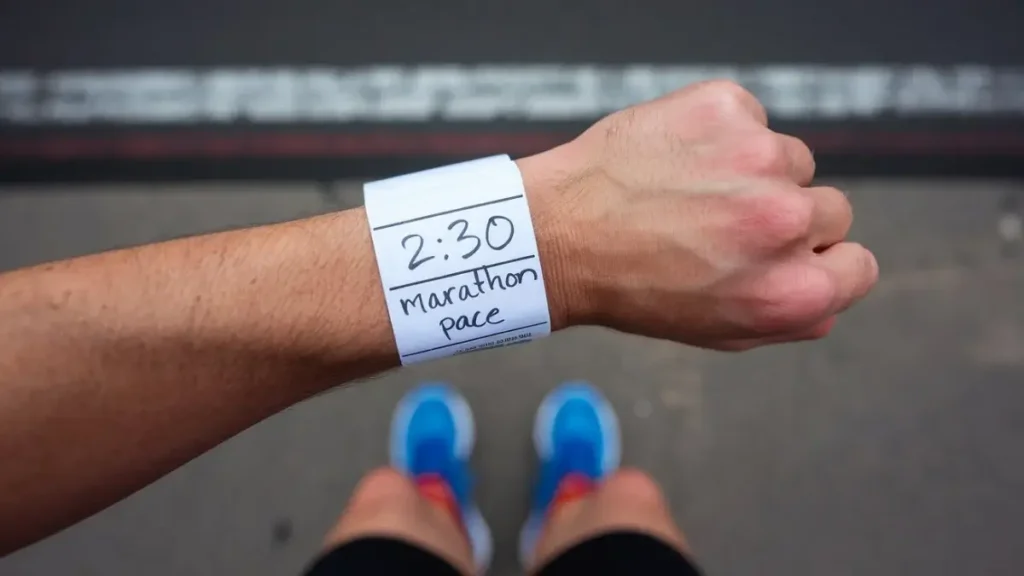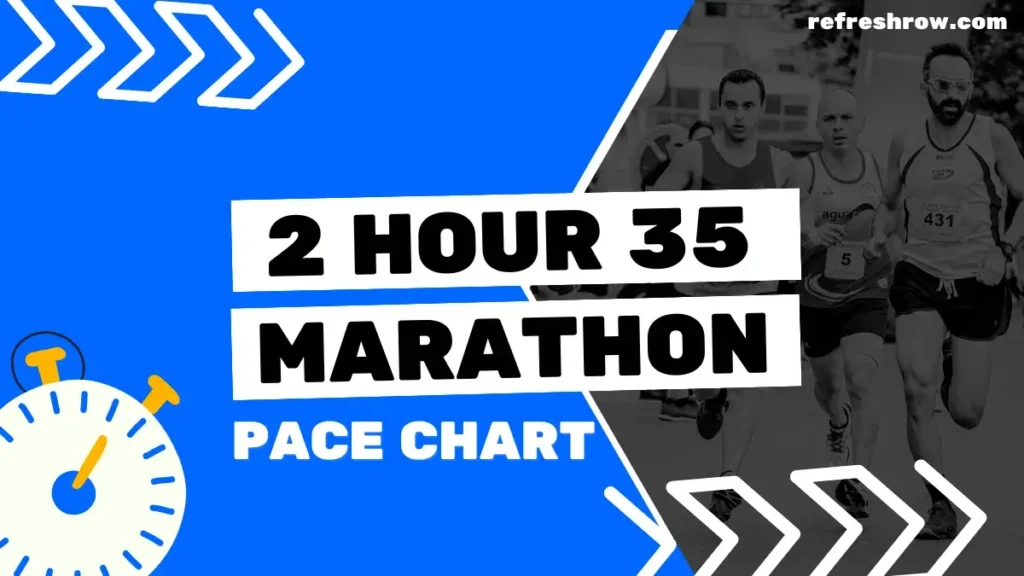To run a 3:30 hour marathon you need to run at a pace of 8:01 per mile or 4:59 per kilometer.
Following the splits below (and shaving off a second), you’ll run a sub 3:30 marathon.
I’d recommend aiming to run 1-2 minutes ahead of the split target time from 10 miles, as you’ll likely come up against crowding on race day.
3:30 Marathon Pace in Miles
| Mile | Split |
|---|---|
| 1 | 8:01 |
| 2 | 16:01 |
| 3 | 24:02 |
| 4 | 32:02 |
| 5 | 40:03 |
| 6 | 48:03 |
| 7 | 56:04 |
| 8 | 1:04:05 |
| 9 | 1:12:05 |
| 10 | 1:20:06 |
| 11 | 1:28:06 |
| 12 | 1:36:07 |
| 13 | 1:44:07 |
| 14 | 1:52:08 |
| 15 | 2:00:09 |
| 16 | 2:08:09 |
| 17 | 2:16:10 |
| 18 | 2:24:10 |
| 19 | 2:32:11 |
| 20 | 2:40:11 |
| 21 | 2:48:12 |
| 22 | 2:56:13 |
| 23 | 3:04:13 |
| 24 | 3:12:14 |
| 25 | 3:20:14 |
| 26 | 3:28:15 |
| 26.2 | 3:30:00 |
Download
3:30 Marathon Pace in KM
| KM | Split |
|---|---|
| 1 | 4:59 |
| 2 | 9:57 |
| 3 | 14:56 |
| 4 | 19:54 |
| 5 | 24:53 |
| 6 | 29:52 |
| 7 | 34:50 |
| 8 | 39:49 |
| 9 | 44:48 |
| 10 | 49:46 |
| 11 | 54:45 |
| 12 | 59:43 |
| 13 | 1:04:42 |
| 14 | 1:09:41 |
| 15 | 1:14:39 |
| 16 | 1:19:38 |
| 17 | 1:24:36 |
| 18 | 1:29:35 |
| 19 | 1:34:34 |
| 20 | 1:39:32 |
| 21 | 1:44:31 |
| 22 | 1:49:29 |
| 23 | 1:54:28 |
| 24 | 1:59:27 |
| 25 | 2:04:25 |
| 26 | 2:09:24 |
| 27 | 2:14:23 |
| 28 | 2:19:21 |
| 29 | 2:24:20 |
| 30 | 2:29:18 |
| 31 | 2:34:17 |
| 32 | 2:39:16 |
| 33 | 2:44:14 |
| 34 | 2:49:13 |
| 35 | 2:54:11 |
| 36 | 2:59:10 |
| 37 | 3:04:09 |
| 38 | 3:09:07 |
| 39 | 3:14:06 |
| 40 | 3:19:05 |
| 41 | 3:24:03 |
| 42 | 3:29:02 |
| 42.2 | 3:30:00 |
Download
Other Marathon Pace Charts
Targeting a different time?
Check out the Full Marathon Pace Chart in Miles or KM
Or select a specific finishing time below:
| 3:00 | 4:00 | 5:00 | |
| 3:05 | 4:05 | 5:15 | |
| 3:10 | 4:10 | 5:30 | |
| 3:15 | 4:15 | 5:45 | |
| 3:20 | 4:20 | 6:00 | |
| 3:25 | 4:25 | 6:15 | |
| 2:30 | 3:30 | 4:30 | 6:30 |
| 2:35 | 3:35 | 4:35 | 6:45 |
| 2:40 | 3:40 | 4:40 | 7:00 |
| 2:45 | 3:45 | 4:45 | |
| 2:50 | 3:50 | 4:50 | |
| 2:55 | 3:55 | 4:55 |
Training for a 3:30 Marathon
Is 3:30 a Good Marathon Time?
Well, what do the stats say?
Run Repeat conducted a study that contains 19,614,975 marathon results from more than 32,335 races across the globe, here is how a 3:30 marathon compares against age and gender for the races recorded:
| Overall | You’re faster than 90.7% of all runners. |
| Male | You’re faster than 86.2% of males. |
| Female | You’re faster than 96.8% of females. |
| <20 | You’re faster than 86.9% of under 20s. |
| 20-29 | You’re faster than 87.0% of 20-29 year olds. |
| 30-39 | You’re faster than 87.8% of 30-39 year olds. |
| 40-49 | You’re faster than 90.9% of 40-49 year olds. |
| 50-59 | You’re faster than 95.7% of 50-59 year olds. |
| >60 | You’re faster than 98.9% of over 60s. |
Training Runs and Paces for a 3:30 Marathon
To break a 3:30 marathon you’ll need to do some serious distance in your training, I recommend at least 35 miles (56km) per week.
You’re also going to need to make sure you’ve crossed off these milestones for other race distances:
- A 5k in 21:50 mins
- A 10k in 45:40 mins
- A half marathon in 1 hour 35 mins
Training Paces
| Pace | Mins per Mile | Mins per KM |
|---|---|---|
| Easy | 9:01 | 5:36 |
| Steady | 8:01 | 4:58 |
| 10k | 7:20 | 4:33 |
| 5k | 7:02 | 4:22 |
| 1 Mile | 6:32 | 4:05 |
Weekly Mileage Targets
| Target Mileage: | Gradually increase your weekly mileage from 40 miles (64 km) to a peak of 68 miles (109 km). |
| Incremental Increase: | Increase mileage by approximately 10% each week, with every fourth week as a recovery week where mileage is reduced by 20-30%. Make sure to taper for the last 1-2 weeks. |
Long Run Structure
| Total Distance: | Build up to long runs of 20-22 miles (32-35 km). |
| Segment Example: | First 5 miles (8 km): Easy pace, heart rate 140-150 bpm (approximately 9:15/mile or 5:45/km). Next 1 mile (1.6 km): Fast pace at 6:50/mile (4:15/km). Next 5 miles (8 km): Medium effort, heart rate around 160 bpm (approximately 7:50/mile or 4:52/km). Repeat: Repeat the segment twice (5 miles easy, 1 mile fast, 5 miles medium), you can taper the final 2 miles if required. |
Why This Works: Incorporating varied paces within long runs enhances lactate tolerance, which helps on race day when you’ve got to maintain pace despite feeling fatigued. By practicing surges during a run, you can build up your physical and mental resilience (lots of elite marathon runners use these strategies during their training)
Alternating Long Runs: Alternate between structured long runs (easy/fast segments) and easier long runs. For easier long runs, maintain a steady, comfortable pace throughout, focusing on mileage rather than speed to aid recovery.
Speedwork Sessions
| Short Intervals: | – 800m repeats at 3:25 per interval (4:15/km). – Aim for 6-12 repetitions with equal time for recovery. |
| Mile Repeats: | – 1 mile repeats at 6:50 per mile (4:15/km). – Aim for 6-12 repetitions with a 1-2 minute recovery jog. |
| Longer Intervals: | – 2 mile repeats at 7:00 per mile (4:21/km). – Aim for 5-8 repetitions with a 2-3 minute recovery jog. |
Recovery and Rest Days
| Rest Days: | You don’t need to incorporate rest days if you are using recovery runs, but I recommend taking 1 (or a max of 2) per week to allow your body to recover and prevent overtraining. |
| Easy Run Days: | Include 1-2 easy run days per week at a relaxed pace of 9:30/mile (5:54/km), covering 5-10 miles (8-16 km) per day. Try to keep your heart rate below 140 bpm on easy days to ensure proper recovery and aerobic development. |
My Tips to Run a Sub 3:30 Marathon
Incorporate Hill Training
One of the most effective changes I made in training for my 3:30 marathon was incorporating hill workouts.
Initially, I was hesitant, fearing that the added intensity may cause more injury than it did good.
But my body recovered more quickly than I expected once I was a few weeks in, and then the benefits really started to show.
It improved my cardiovascular strength and running form, making flat terrain feel easier.
I scheduled one hill workout each week, which involved running up a steep hill at a strong effort for about 60-90 seconds and then jogging back down to recover.
An unexpected upside was that it also built up my mental resilience. When I came up against a hill on marathon day, I was able to confidently tackle them and maintain a steady pace.
Fuel and Hydrate Like a Pro
Another key lesson I learned was the importance of dialing in my nutrition and hydration strategy.
During my long runs, I experimented with different types of gels, chews, and hydration drinks to find what worked best for my body.
I practiced consuming these at regular intervals to avoid energy crashes.
I ended up with a big gulp of water every 20 minutes, and an energy gel with a Lucazade chaser every 30 minutes.
Proper fueling and hydration kept me energized and prevented the dreaded “bonk” in the later miles.
Don’t do anything new on race day, stick with the plan that tried and tested and know works for you.
Engage in Active Recovery
Instead of complete rest days, I included activities like yoga, swimming, or light cycling to keep my body moving while allowing my muscles to recover.
And active recovery ended up becoming a key tool in my running kit bag.
These activities helped improve my flexibility, reduce muscle soreness, and maintain my cardiovascular fitness without the impact of running.
I found that incorporating active recovery days helped me bounce back quicker from intense workouts and long runs, keeping my overall training on track and reducing the risk of injury.
Join a Running Group
One of the most enjoyable and beneficial aspects of my marathon training was joining a local running group, the “Orange Tangerines”.
The camaraderie from fellow runners helped to keep me motivated when the weather was bad and accountable to myself.
Group long runs made the miles fly by, and the competitive spirit pushed me to improve.
Additionally, experienced runners in the group offered valuable insights and advice that I wouldn’t have discovered on my own.
Being part of a community turned training from a solo venture into a shared journey, making it more rewarding.


Row Brown is the founder of Refresh Row. He is a keen marathon runner, his favorite being the London Marathon. He’s now set himself the mission of Running the Entire Length of Spain, which is scheduled for late 2024.


